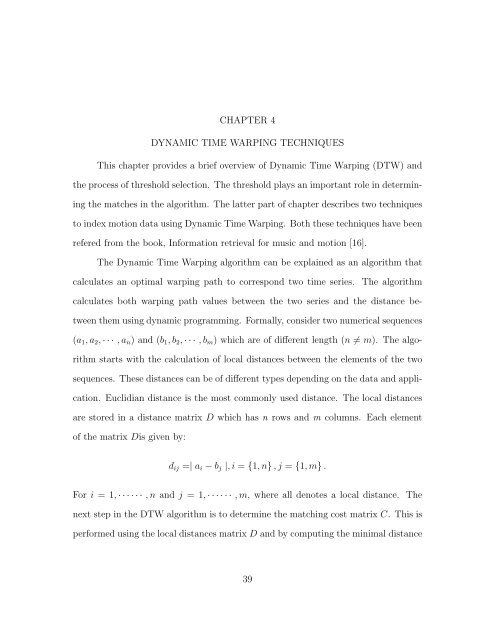A COMPARISON AND EVALUATION OF MOTION INDEXING ...
A COMPARISON AND EVALUATION OF MOTION INDEXING ...
A COMPARISON AND EVALUATION OF MOTION INDEXING ...
You also want an ePaper? Increase the reach of your titles
YUMPU automatically turns print PDFs into web optimized ePapers that Google loves.
CHAPTER 4<br />
DYNAMIC TIME WARPING TECHNIQUES<br />
This chapter provides a brief overview of Dynamic Time Warping (DTW) and<br />
the process of threshold selection. The threshold plays an important role in determin-<br />
ing the matches in the algorithm. The latter part of chapter describes two techniques<br />
to index motion data using Dynamic Time Warping. Both these techniques have been<br />
refered from the book, Information retrieval for music and motion [16].<br />
The Dynamic Time Warping algorithm can be explained as an algorithm that<br />
calculates an optimal warping path to correspond two time series. The algorithm<br />
calculates both warping path values between the two series and the distance be-<br />
tween them using dynamic programming. Formally, consider two numerical sequences<br />
(a1, a2, · · · , an) and (b1, b2, · · · , bm) which are of different length (n = m). The algo-<br />
rithm starts with the calculation of local distances between the elements of the two<br />
sequences. These distances can be of different types depending on the data and appli-<br />
cation. Euclidian distance is the most commonly used distance. The local distances<br />
are stored in a distance matrix D which has n rows and m columns. Each element<br />
of the matrix Dis given by:<br />
dij =| ai − bj |, i = {1, n} , j = {1, m} .<br />
For i = 1, · · · · · · , n and j = 1, · · · · · · , m, where all denotes a local distance. The<br />
next step in the DTW algorithm is to determine the matching cost matrix C. This is<br />
performed using the local distances matrix D and by computing the minimal distance<br />
39
















